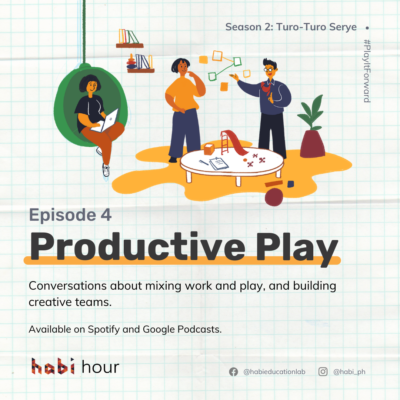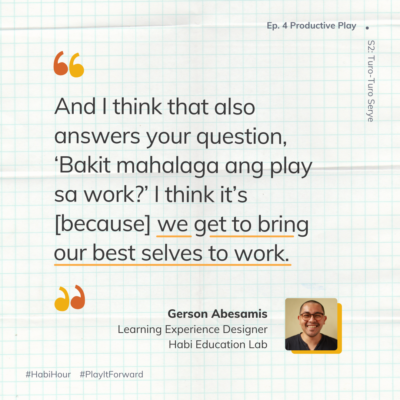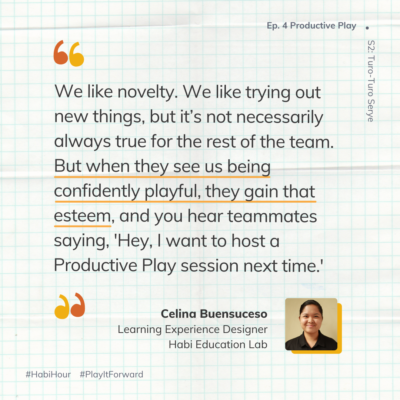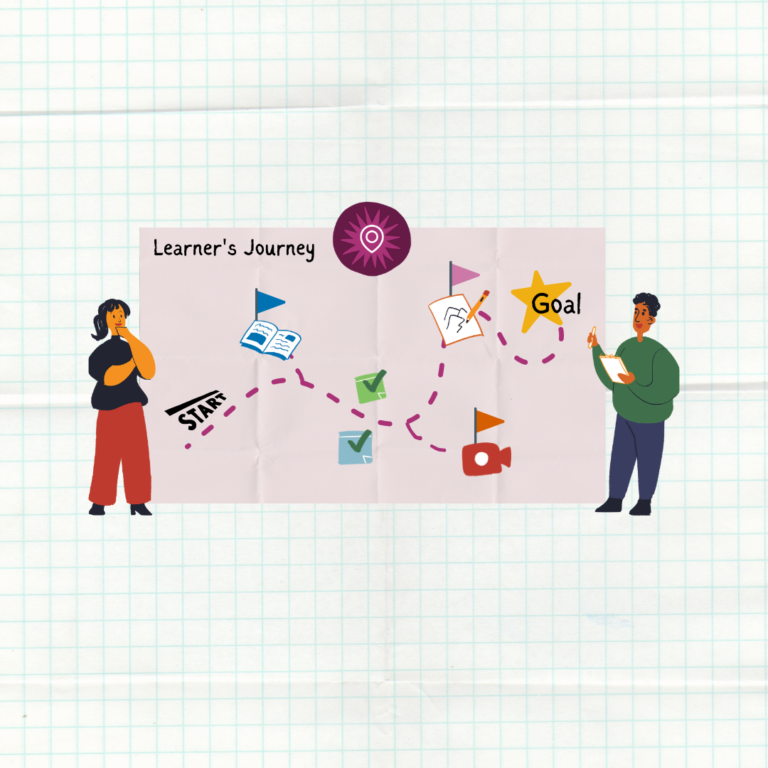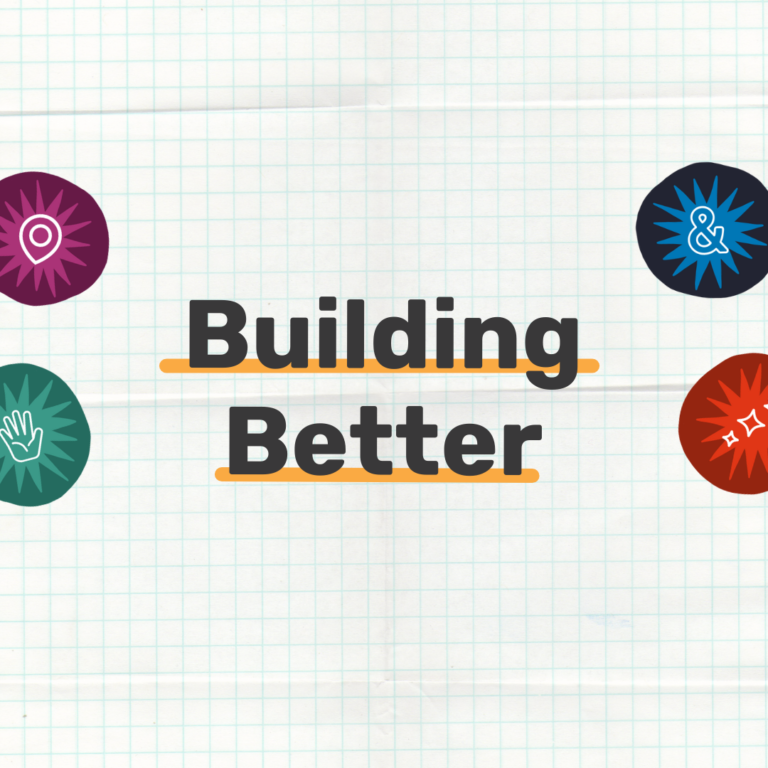Conversations about mixing work and play, and building creative teams
Overview
30 April 2021 | 17 min and 03s
In episode 4 of Habi Hour’s Turo-Turo Serye, we step out of the classroom to talk about the positive effects of playfulness to creative teaching, learning, and productivity. Listen to Celina and Gerson share about how we use playful methods in our work processes, and see how you can also apply the same principles in your work or school setting.
Transcript
Introductions and Check In
JPAUL: Simula nitong Enero, kami nina Celina at Gerson ay gumawa ng pakulo para sa aming kapwa LXD sa Habi. Tinawag namin itong “Productive Play Sessions.” Simple lang ang konsepto nito – maglalaro kami sa Habi bilang anyon ng training o upskilling session at para bumubo ng bagay o sistema na makakatulong sa amin sa pagtratrabaho. Isa sa mahahalagang sangkap ng mga session na ito ay ang playful method. Mapaglaro dapat ang pamamaraan namin sa pagbubuo at pagkatuto. Pero bakit? Ano ba ang halaga ng pagiging mapaglalaro sa pagtratrabaho?
Kuwentuhan
CELINA: I guess kasi kapag naririnig ko yung word na play nagmumula kasi ako sa very early childhood education perspective. Sa early childhood kasi sinasabi natin na “play is the occupation of the child.” That is what they are supposed to be doing, that is what they are meant to be doing. So yung play for me, it’s a natural language of a child and perhaps people who have qualities of being child-like.
GERSON: Dagdagan ko rin iyon. Ang ganda nung idea of “play being the occupation of the child.” I think, kadalasan when we adults think of play it is something reserved for our youth, or our children – something that we shouldn’t be doing anymore because we have grown up as adults and we have to participate in the adult world pero I beg to disagree. I think this is one of the unfortunate trends that play is equal to unserious things; play is equal to trivial things. Para sa akin mahalaga ang play dahil it keeps you creative, it keeps you delighted about the work that you do and the life that you have. Kung babalikan lang natin, I know that many of the people in the workplace would champion training programs or upskilling programs that are high in technical skills but time and time again, creativity has been at the top of the skills of HR practitioners or leaders that they are looking for in new hires or in their teammates and how do you be creative, I think being playful is a way to exercise your creativity.
Tingin ko doon din sa sinabi ni Celina, aside from being a natural language of children, it is also a natural language of being a human person.
CELINA: Sobrang agree ako doon. Pero alam mo it’s one thing that I realized in Habi lang, to be honest – yung value of play even at work. Kasi siguro in my past workplaces, very serious talaga. Even having that delineation na “there’s work, and there’s play,” diba? Ganoon talaga yung kulturang nasalihan ko or pinagdaanan ko in my past workplaces pero nung dumating ako sa Habi, sabi ko, “Ok, parang normal lang maglaro? Bakit ganoon? Bakit yung kultura ay parang paglalaro?”
GERSON: Kasi sabi mo rin, kultura. Feeling ko hindi lang siya sa workplace. Napaisip din ako, I think even sa schooling natin. If you were part of a traditional school, maybe you can recall a teacher that said, “Ay, no games. You can’t bring card games inside your classroom” or “No laughing or else you’ll face the corner.” I think we’ve also been socialized into the dichotomy nga na play is not serious work and being productive is serious work, so therefore being productive is not equal to being playful.
CELINA: Parang yung teachers being playful, naisip ko lang din, when did I feel like my best self when I was a student? And then yung nababalikan ko talaga ay yung mga times na hinayaan lang ako ng teachers ko na maglaro, to figure things out on my own. I just realized na the best moments for me in school are also linked to the times that I had permission to play.
GERSON Maybe that also answers your question bakit mahagala ang play sa work? To your words, Celina, we also get to bring our best selves to work when we get to play.
JPAUL: Bringing out our best selves to work when we play. At dahil nga dito at sa iba pang mindsets tungkol sa paghahalo ng pagtratrabaho at paglalaro, nabuo namin ang productive play sessions.
GERSON: Yung pinakarecent ang pangalan niya ay “Gayahan 2021.” Yung unang bahagi noon nagkaroon ng reflections kung sino ba yung mga naging inspirations natin bilang designers; not thinking of being creative that is something totally original but being creative actually is taking in your influences and being aware of your influences and studying them closer. And that led to playful small group sessions on using a tool that we used in Habi called “Learning Experience Blocks.” In small groups, naglaro-laro lang kami to explore and just to tinker with the blocks but also with that idea in mind that we can get inspiration from other Learning Experiences or from other creative platforms, not just online learning, or learning designs, but through films, through television shows, through music, poetry, through buildings and architecture, through clothes and color, and paintings.
CELINA: Yung isa ano, tinawag nating, “Malay Mo Magwork.” It’s more a play session where we got to try the concept of “Digital Rooms.” Yung “Digital Room” being a shared space among participants. In our case, we tried using Google Slides kung saan one slide can be one room and then you have avatars there representing different participants or different people who are in that digital room. At the end of it, we were really just playing around with it na parang may nagset-up ng buffet, may nagset-up ng museum, pero more than that, yung pinuntahan nito, I saw a lot of projects afterwards that tried to incorporate digital rooms because through that play, nakita natin yung value of having a visual – connect the participants
JPAUL: Did we just play for the sake of having fun? Bukod nga sa playfulness, malaking bahagi rin ang productivity – upskilling man iyan or problem-solving tulad ng designing for accessibility at improving our systems and processes. Nang balikan namin, marami na rin pala kaming playful methods na ginagamit sa pagtratrabaho.
CELINA: I think one way we play in Habi is with our very roles at work. You know in one project I am the facilitator of a workshop; In another project I am the one communicating with the participants, yung mga registration; or in another project I might be the one making the slides. You don’t really get stuck in one role. Parang in different projects, you get to experiment on different roles, you get to wear different hats and in that process, nakikita mor in where am I thriving or what am i good at. Ano yung mga parang nagigigng interest ko na akala ko dati hindi ko naman bet.
GERSON: Isa naman mostly on materials that we work with or the platforms or the mediums that we use. When I think of play rin kasi I think of, siyempre yung anak ko nga na that sometimes gets immersed in let’s say, a few cardboard materials and her markers, and she would just make things on her own. So may kaunting role play, may kaunting imagination trying out, pwede ba ‘to, kaya ba ‘to? So we always have that space in our projects, I think it’s in the nature of our work. One dahil human-centered design or design thinking is a big part of our process sa Habi at pangalawa, the type of projects that we work on, say online learning or diverse teacher training experiences or some learning community workshops, karamihan ng mga projects natin sometimes, even our partners, are open to experimenting new ways. And so we would also find ourselves spending time just working on things like trying out will this work in this tool? Can we try this workshop on another platform? The first times that we did recordings for Habi Hour, this podcast, it was playful in the sense na parang even up to the point of editing, we were trying out different editing platforms, editing mechanisms. So there’s also that idea of play as tinkering and play as somewhat parang free type of creative work.
JPAUL: Nasa kultura namin sa Habi ang playfulness at napansin nga namin na sa mga pagkakataong nagiging makulit, kuwela, o kalog kami sa opisina, may kakaibang nangyayari o kakaibang epekto ito sa amin bilang mga tao.
GERSON: Ako una kong napapansin, yung improved peer relationships. I think if we recall back to our childhood selves, and even siguro up to our adult selves, when we play with someone, traditional games or sports, dahil nasa environment kayo na may pagka-low stakes – it’s play, it’s fun. Socialization is easier or because you team up towards a particular goal or you discover things together; you see each other fail and then you cheer each other on, “sige kaya lang.” I think those types of interaction in playful scenarios, tend to develop better relationships.
And siguro yung pangalawa is improved wellbeing yung sinabi ko nga na play improves the wellbeing of an individual. It makes them feel freer, feel autonomous, feel they have agency over their time or over their creativity; and it makes us feel, over-all, better. Ulitin ko nga yung sinabi kanina na we are able to bring our best selves to work.
CELINA: Yung i-a-add ko building on what Gerson said about socialization aspect of it. I guess because of that socialization kasi, parang nakikita ko siya as an opportunity to gain the esteem of the people you are working with. Kunyari tayo bilang team na nagpakulo ng productive play sessions. Kasi tayo alam natin iyon na makulit talaga yung mga utak natin. Na we like novelty, we like trying out new things but it is not necessarily true for the rest of the team, not always true, diba. Pero when they see us being playful, being confidently playful, they gain that esteem and then you hear teammates saying, “I want to try hosting a productive play session next time.” And I think that is such a beautiful effect or impact on people we work with.
Tapos, I guess one more thing na napansin ko is – I guess, we are a pretty metacognitive team. Play sessions make you even more metacognitive because napag-usapan natin kanina, we are kind of predisposed that “maybe we shouldn’t be playing at work.” And when you come in with that conception, mas ma-coconscious ka na “bakit ako naglalaro?” So at the end of it, iisipin mo, “what did I get out of that?” You become more metacognitive and you try to think, “how is that productive for me?”
GERSON: Ako rin, dagdag ko rin. I think if you’re, lalo na thinking about the listeners – if they are a leader, managers, or probably in HR, learning and development practitioner, why is play important for their employers or their teams – I think it will also lead to particular outcomes of their work. Maybe more ingenious ways to do things, more efficient ways to do things. Play is also about iteration and play is also about testing boundaries so when you are playful, you also try to think, “maybe there’s something better”, “maybe I can do this in a different way.” Siguro yung halimbawa noon we have a tool called “Trabaho Tracker” and it’s a way for Habi to measure the amount of hours and the amount of work that each of the learning experience designer put in a project or in a month. It went through a lot of iterations. Naalala niyo ba yung mga “kala-Habi”, yung Google Sheets version, yung table version. Naalala niyo yung paper version? It went through a lot of iterations. And for example if the culture isn’t playful, it would have been, let’s just get an enterprise software. We are just going to report our hours in a particular way. We are just going to do how other businesses do it but I think if you introduce play as a culture in your team, you will get solutions that are more fit to your team, and you will discover the hidden talents of your team, of your teammates that might lead to interesting results. I guess also to say that play will not solve all problems. I think it can lead to different solutions. It can lead to reframing the challenge into something else that might lead to a solution.
Check out
JPAUL: Kung susumahin sa paglalaro, wala masyadong pressure. Dahil walang pressure, mas malaya at mas kompyansa mag-experimento, mangalikot, at tumuklas. At dahil creative ang method, madalas, creative rin ang resulta.
JPAUL: Sa pagtatapos ng episode na ito, let’s complete the sentence – “Mixing work and play is…”
CELINA: Gusto kong maglaro kaya magpapasway ako ng kaunti sa syntax mo. Mixing work and play makes healthy teams.
GERSON: Mixing work and play is enjoyable, sometimes challenging, but always worth it.
[Music: Habi Hour Outro]

